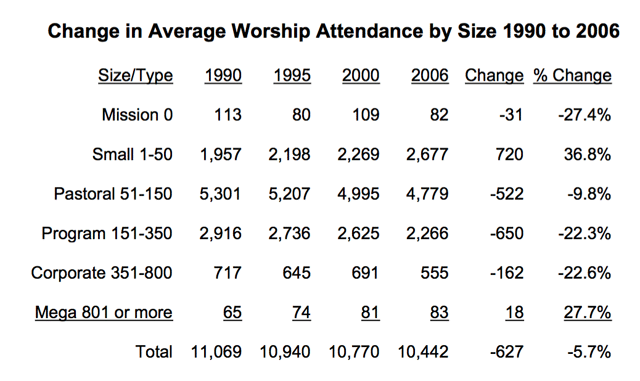When the Church Ignores Statistics
Mission Can Be More about Property Rights than Saving Souls
Here is an interesting report found in the ELCA’s statistics online. This is a direct screenshot.
Do you see where the trend for growth is? It is in SMALL CHURCHES!
Pastoral Churches with 51-150 members have a much slower rate of decline than all other categories.
Small Churches are actually showing growth. Significant growth.
Small Churches and Pastoral Churches together comprise a significant percentage of all churches. Things aren’t as bleak as we sometimes think. We are just defining success inaccurately.
This report was published in 2008, the year lawsuits were filed in our church case. The chart shows the change in worship attendance from 1990 to 2006—the year Bishop Burkat first approached Redeemer with a copy of her constitution in hand.
Redeemer was one of the churches showing growth when this report was published in 2008. In fact, in 2006, we were the only small church in SEPA Synod that church statistics showed as growing. Most congregations in every category were showing decline. These records were altered during the court battle. There SEPA represented our congregation as having only 13 members at the same time they were holding us to a quorum for 82 members. In fact, we had tripled our membership between 2006 and 2008 to more than six times the 13 SEPA was counting.
Fortunately we have a screen shot from before the record was doctored. See for yourself.
More interesting are the figures for Mission Churches. SEPA was hot to make Redeemer a Mission Church. As it ends up, we were smart to resist this proposal.
The status of Mission Church sounds like leaders are trying to help—but the status of Mission Church actually changes the relationship of a congregation to the Synod. If they accept the status they forfeit rights to their property. It is really just a sneaky way to gain control of congregational property. They tell congregations that’s it is about starting fresh without the baggage of the past. That’s a ploy. It’s about property. Once Mission Status is assigned, the congregation will not be able to leave the ELCA with its property — EVER!
Churches with Mission Status are failing faster than any other category save Mega-Church. When they fail, property issues are already decided.
We discovered this for ourselves when we visited Spirit and Truth in Yeadon a few weeks ago. Their story was cited as an example of what SEPA could do for us if we would only cooperate.
In 2006, Spirit and Truth was a freshly chartered church. SEPA had started this congregation by closing the existing congregation and making it a mission church. New name. New management. New rules. The people of Yeadon—old and new—lost control of their property. Now, eight years later, their numbers are lower than when they were chartered.
If SMALL CHURCHES are where the best potential for growth lies, why are they targets for closure? Why are they encouraged to enter a failing model? Why are members expected to transfer memberships to churches that face tougher challenges?
The answers lie in the needs of hierarchy to control property and manage the stable of professional leaders. Members and mission are lower priorities. When budgets are failing, there is little incentive for SEPA to help small churches succeed. Small churches are their security blanket, their bank, their nestegg for their own rainy day.
The thinking is shortsighted. Small churches have the best chance at making a difference, but there is no plan to provide the necessary leadership. The lucky ones have able lay leaders. Failing that, they will soon be on the list of churches that synod feels must be closed. (But first your synod might pretend they are going to try to reopen the church as a mission church, so they’ll benefit from the property.)
Time for the ELCA to pay attention to its own data!
Time to find answers for strengthening small churches.
That’s where your best potential for long-term mission success lies.

